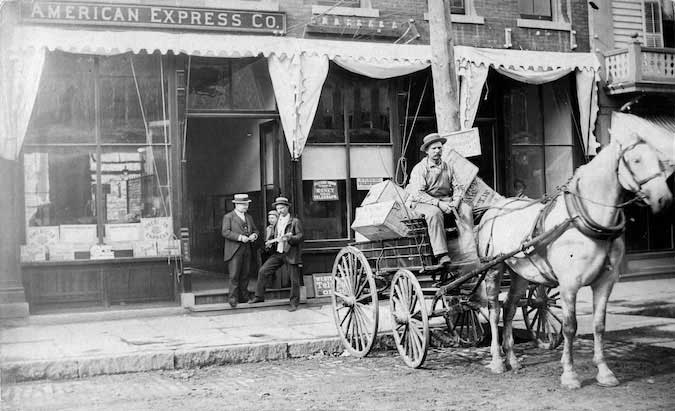Western Union Telegraph & American Express operated in downtown Albion in early 1900s
“Overlooked Orleans” – Vol. 6, No. 15
ALBION – This image, taken around 1900, shows a brick building on the north side of East Bank Street in Albion at the present site of Phoenix Fitness. In the years following this photograph, the office service as the telephone building prior to its relocation to Platt Street.
Based on identifying information on the obverse side of the photograph, we know that J. B. Gamble of Eagle Harbor produced the image. A handwritten note states that Freeman Herrick is the man seated atop the express wagon. A quick look at the 1900 U.S. Census shows us that Freeman Herrick, of State Street, was working as an expressman in the village. His work in this office began around 1880, working first as a commission agent, then as an express messenger operating the Albion to Buffalo line. The wagon is fully loaded with boxes, either prepared for transport to the railroad depot on Clinton Street, or awaiting delivery to residents in Albion.
The sign over the storefront indicates that this building was an American Express office. Started in 1850 at Buffalo, NY, the American Express company handled express freight shipments by railroad. Growing exponentially in the latter quarter of the 19th century, the company’s total assets by 1903 totaled approximately $28 million; only second to the assets held by the National City Bank of New York. In 1857, American Express launched their money order business in order to compete with the U.S. Postal System’s money order option.
To the right of the American Express office was the Western Union Telegraph Office. Established at Rochester in 1851 by Samuel Selden and Hiram Sibley, their New York and Mississippi Valley Printing Telegraph Company eventually combined with another company to form the Western Union Telegraph Company in 1856. Just as the American Express Company had established in 1857, Western Union developed their own money transfer service in 1871.
The identity of the two men and boy standing in the doorway are unknown, though it is presumed that one of the men is the office agent. In early 1901, John Napier was sent from Batavia’s express office to assume management of the Albion office. In turn, A. W. Myers of Albion was sent to Batavia to replace him.
As an aside, Freeman Herrick’s daughter, Margaret, met a young man in this office around 1903 and the two fell in love. According to local reports, Margaret was “addicted to the liquor habit” and her new beau attempted to break her habit. In December of 1903, Margaret wrote to the man and asked him to see her. When he refused, she committed suicide by taking a lethal dose of carbolic acid in Rochester.








































































